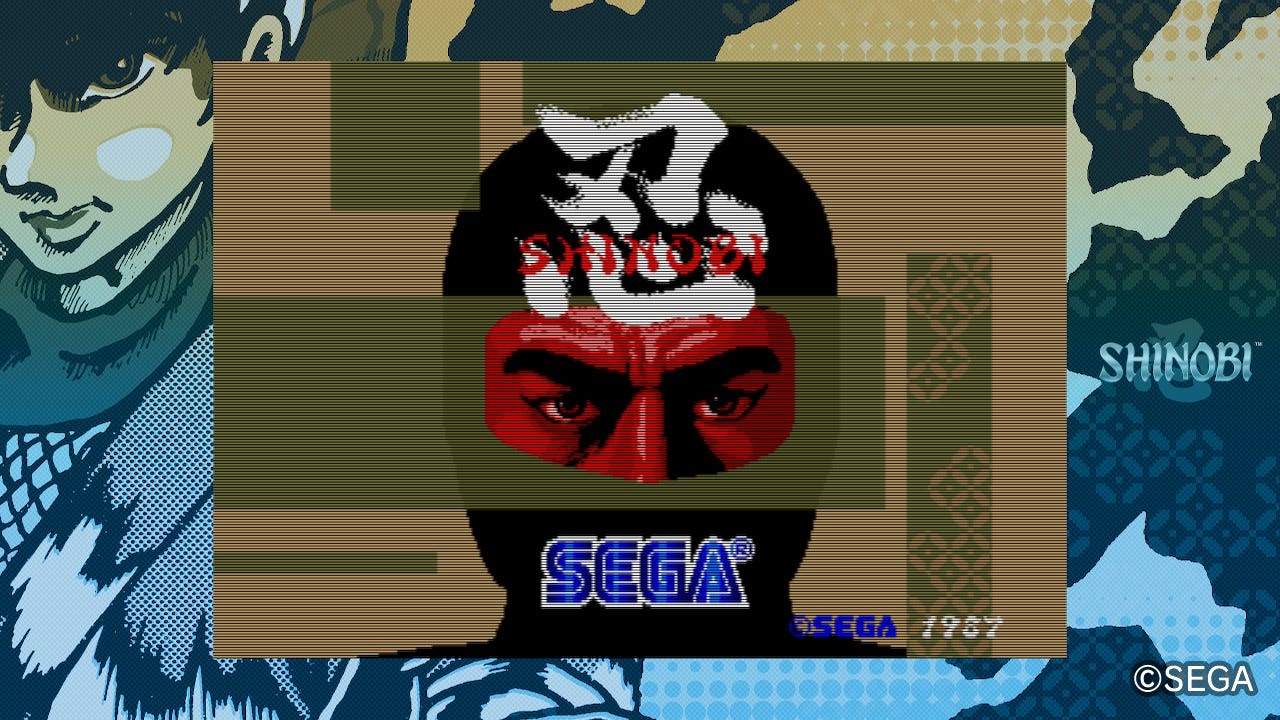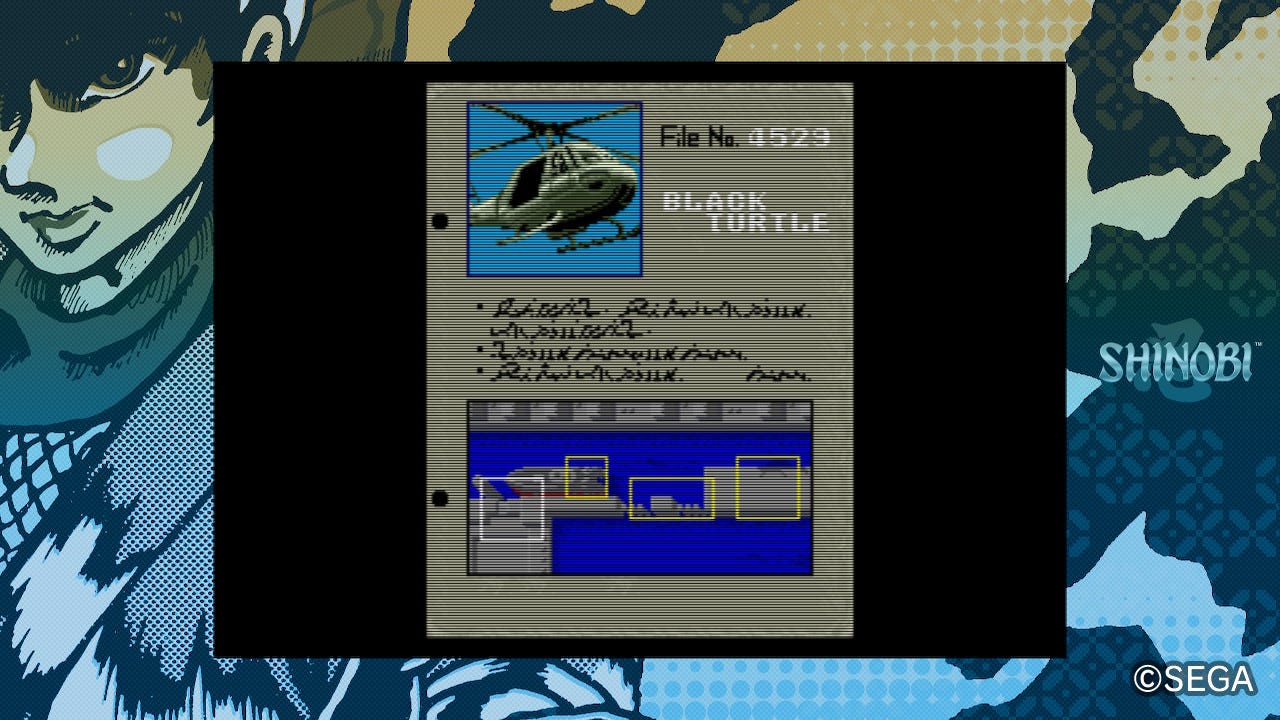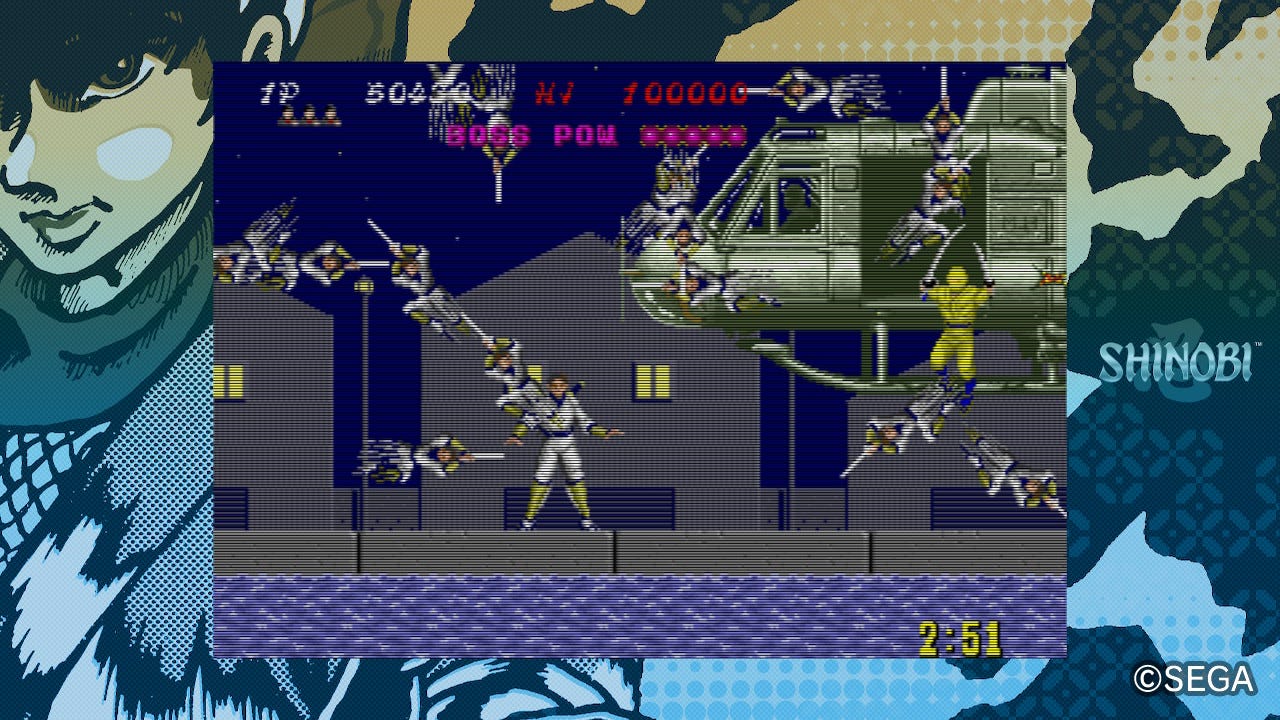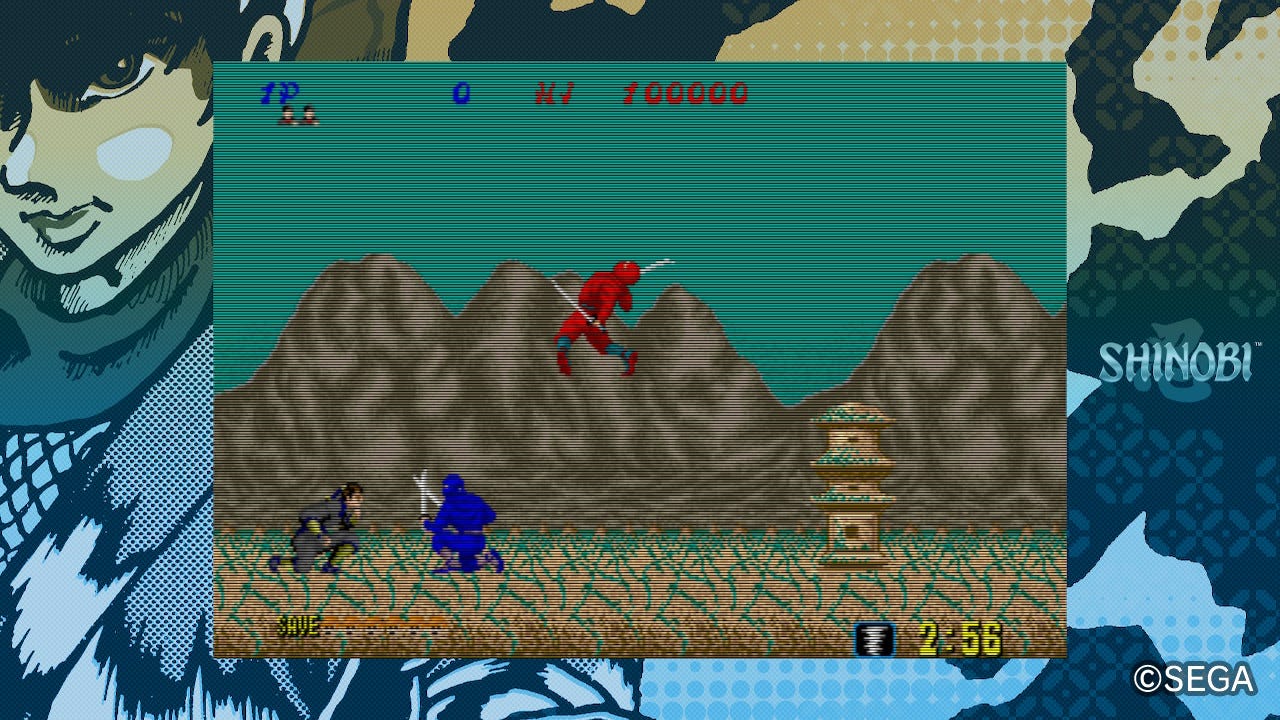XP Arcade: Shinobi
Sega's influential arcade original from 1987 has a new life in the present, thanks to the Ages series of updated re-releases.
This column is “XP Arcade,” in which I’ll focus on a game from the arcades, or one that is clearly inspired by arcade titles, and so on. Previous entries in this series can be found through this link.
The series has fallen by the wayside a bit at this point, with its latest new release back in 2011, but Shinobi was a significant hit for Sega when it debuted internationally in arcades back in 1987. This particular game ended up with a number of ports — to Sega’s own Master System, of course, to the PC Engine, to a whole bunch of Japanese computer platforms, and even to the Nintendo Entertainment System. Yes, a Sega game on a Nintendo platform in the 80s, but don’t get too excited: this wasn’t Sega’s doing, it was Tengen, the Atari Games subsidiary that released unlicensed games on their own black cartridges for the NES, in order to get around Nintendo’s control of the cartridge supply and a level of top-down quality control that Tengen’s ports probably needed. Sure, Tengen didn’t have the rights to any of what they did, but Sega didn’t have the rights to Marilyn Monroe’s or Spider-Man’s likenesses, either, and that didn’t stop them from putting both in Shinobi. The 80s, everyone.
Shinobi also ended up launching a franchise and a number of spinoff series, and this was all possible due to that first arcade title. It’s still a lot of fun today, as basic as it is compared to the faster paced Shinobi that would come later: don’t use whichever console ports of Shinobi you might have played as a guide for whether the arcade version is worth your time. The Master System version of Shinobi is fine, but it’s a much different game than its source material both visually and in how it plays.
Shinobi might seem simple enough on the surface — one button for attacks, whether that’s the ranged shuriken or the melee sword, a second button for a once-per-stage ninja magic attack, jumping, ducking — but everything is layered enough that this simplicity never feels boring. There are plenty of enemies to fight off, coming at you from multiple directions, sometimes appearing out of thin air or leaping out from behind or underneath. You have to traverse two different areas, too: it’s not quite foreground and background, but it is a higher or lower floor situation that works the same in practice, as you can only interact with enemies or ninjas in need of rescuing on the floor you’re currently on. On the bright side, the same rules apply for your foes, so you won’t catch an errant dart or bullet from a “background” enemy if you’re in the “foreground.” And you can switch between the two at any time, as well, and should strategize around that fact, even, so that you can sneak up behind shielded enemies or those in a position where they could get the jump on you otherwise.
Shinobi seems easy enough at first, but that changes right around the time you get comfortable with how the game works. For one, you can take just one hit before you die, and lives are limited, being an arcade game and all. Shinobi was designed to take your quarters away, which is why you can’t take much punishment, why bosses tend to have very tiny weak points you need accuracy and timing to hit, and so on. So, yes, things are easy when they are designed to ease you in, to let you see that your goal is to rescue these tied-up ninjas after plowing the road with shuriken, but then you start to get the foes who hang on walls and drop down, or ninja who appear out of thin air and will sometimes flank you, forcing you to prioritize attacks and move in such a way that you don’t die when they both close the distance between you. And don’t forget about the various projectiles, be they darts or bullets or burly dudes with shields who only lower them in order to throw their boomerang-esque swords at you.
Luckily, you can figure out a way to do a bit of crowd control with some practice: while you can only take one hit before dying, those hits have to actually be from a weapon. If you decide to just ram into an enemy’s body with your own, you can briefly stun them: it will stun you, too, but if you do it right, you can use this as a way to fend off one attacker before recovering and eliminating another: the enemy’s threat is in their numbers and their projectiles, they are not exceptional thinkers who are going to out-strategize or out-reaction time you.
You play as Joe Musashi, a ninja seeking to rescue the ninja kids who have been kidnapped by the criminal organization known as Zeed. The game is broken up into missions, with Joe going from place to place to rescue these kids and defeat the various lieutenants of Zeed, until he can finally confront the mysterious master of this criminal network. Each mission opens up with the game showing you a file photo of the boss you need to take down, and the area you’ll be traversing to get there, which is broken up into three or four stages plus said boss fight, depending on how early or late into the game you are. And yes, one of those bosses is literally just a helicopter full of ninjas that you need to defeat with shuriken.
In addition to the standard stages, there are also bonus levels which put you in a first-person perspective, and have you throwing shuriken at incoming ninja. There is no penalty for failing this, but they are a chance to rack up bonus points, and points lead to extra lives. Plus, if you manage to achieve a perfect on these bonus stages, you’ll earn an extra life outright. No small thing for an arcade game, but it will take practice to get there: the ninja run in from both sides of the screen, and if you don’t take them out, they will advance closer to you. If they advance a second time, then they’re going to hit you and end your shot at earning an extra life. They’re a fun diversion from the main game, and worth mastering, because you are going to want those extra lives as the game progresses.
The Master System might have had some pretty powerful tech in it for an 8-bit console, but the difference between its version of Shinobi and what was in arcades is still stark. The sprites are much larger in the arcade version, the backgrounds and enemies are all so much more detailed. Here’s gameplay from the Master System port of Shinobi…
…and here’s what the arcade original looked like:
So much more detail! Everything is so much bigger, the gameplay is faster and smoother — arcade Shinobi is more methodical and slower-paced than more modern Shinobi titles, sure, but compared to its ports, it feels fast — and then you also have the sound, which is superior. Shinobi ran on the System 16 arcade board, which was 16-bit, compared to the SMS’s 8-bit hardware, so the reasons why are obvious. Still, it’s striking to see those differences in action, especially if you’re used to the home conversions.
There were also changes to how Shinobi would play on the Master System, not just in how it looked and sounded. The game introduced a life bar for Joe, which let him take a few hits, and while rescuing the kidnapped ninja children was no longer required, you would be foolish to ignore them, because you earned power-ups and life recovery for doing so. It’s a solid enough game, though, it plays a little slow these days in part because the movement feels much stiffer than in its arcade counterpart. If you had to play just one, you’d want it to be the arcade version, and not just because it looks and sounds better.
Luckily, the Sega Ages version that released on the Nintendo Switch in 2020 includes both the original arcade version and an Ages-specific variant that blended some of the Master System version’s changes into it. Now you can take two hits before dying instead of one, and rescuing enough kidnapped kids will refill your “health” to let you go beyond just that one mulligan. Joe’s health status is represented on-screen by the color of his outfit: if he’s wearing white, he’s at full health, and red means the next hit will kill him.
The Sega Ages release includes much more than just this variation on the arcade classic, however. The game, developed by M2, also has the kind of modern quality of life tweaks and additions you expect from this generation of Ages releases, like button mapping, scanlines and smoothing options, wallpapers, different options for stretching the image (don’t do that, please), making it fit the screen, or going pixel perfect. Both the international and Japanese releases of the game are included. There are difficulty options that don’t just change the overall intensity of the game, but also let you adjust the speed of enemy projectiles.
And, most importantly, there is also a rewind option. You can turn this on or off before you even start the game, and which online leaderboard your score would appear on is determined by that. It’s a great addition if you just want to learn how Shinobi works, or not be burdened by the idea of failure. Remember, no one forces you to use a rewind feature, but having it there for people who want it is wonderful. And I say this as someone who loves when a game tries to break me.
The last major Ages addition is the ability to start from any mission or stage within the missions that you’ve already played before, so if you didn’t finish your playthrough of the game and wanted to resume, or maybe you don’t like where you saved and left off and wanted to go back a stage or two in order to give yourself some more chances at earning extra lives or what have you, you can do that. It’s also useful if you want to take a screenshot of two ninjas coming after Joe but don’t want to play 20 minutes to get to a point where that’s going to happen organically:
Sure, that’s a pretty limited use case, but it worked for me just now.
Shinobi might not seem like a groundbreaking title now, but in 1987, the things it were doing were still fairly new. The home conversions might have aged a bit, but the arcade original is still a lot of fun to play, and the $8 Sega Ages re-release makes that even more the case. Modern quality of life options, the more forgiving Ages-exclusive mode that admits the game doesn’t need to take your quarters from you any longer, and an ability to play all of this without having to resort to emulation or the luck of having already bought it on the Wii Virtual Console years and years ago.
While the Sega Ages version of Shinobi from 2020 is a Switch exclusive, you can still get the arcade game on your modern-day Xbox systems. It’s available on the Xbox 360, and since the One and Series X|S systems are backwards-compatible, you can simply play it there. It’s just a straight-up emulation job on there, not like the Sega Ages version, but still. If you lack a Switch, have $5, and want to experience the original Shinobi, you can. Well, minus the Spider-Man-looking enemies and the Marilyn Monroe portraits, anyway. It’s not 1987 anymore, you know.
This newsletter is free for anyone to read, but if you’d like to support my ability to continue writing, you can become a Patreon supporter.





